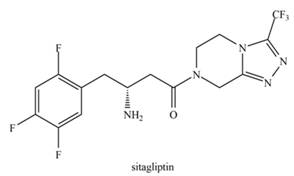
ORGANIC CHEMISTRY
5th Edition
ISBN: 9781259977596
Author: SMITH
Publisher: MCG
expand_more
expand_more
format_list_bulleted
Concept explainers
Textbook Question
Chapter 17, Problem 17.14P
Januvia, the trade name for sitagliptin, was introduced in

Expert Solution & Answer
Want to see the full answer?
Check out a sample textbook solution
Students have asked these similar questions
(a)The concept of hybridization was first proposed by Linus Pauling in 1931,
that explain about the concept of mixing orbitals to form new hybrid
orbital suitable for the pairing of electrons to form chemical bonds. Draw
the kekule structure of a compound that contains only carbon and
hydrogen atoms that has:
(1)
One sp hybridize carbon, two sp? hybridized carbons and two
sp hybridized carbon
(ii)
Two sp' hybridized carbon and two sp hybridized carbons
(ii)
Two sp? hybidized carbons and two sp hybydized carbon
True or false: (a) The C¬C bonds in benzene are all the samelength and correspond to typical single C¬C bond lengths.(b) The C¬C bond in acetylene, HCCH, is longer than theaverage C¬C bond length in benzene.
Linoleic acid is an essential fatty acid found in many vegetable oils, such as soy, peanut, and cottonseed. A key structural feature of the molecule is the cis orientation around its two double bonds, where R1 and R2 represent two different groups that form the rest of the molecule.
(a) How many different compounds are possible, changing only the cis-trans arrangements around these two double bonds?
(b) How many are possible for a similar compound with three double bonds?
Chapter 17 Solutions
ORGANIC CHEMISTRY
Ch. 17 - Prob. 17.1PCh. 17 - Problem 17.2 What orbitals are used to form the...Ch. 17 - Problem-17.3. Give the IUPAC name for each...Ch. 17 - Prob. 17.4PCh. 17 - Problem-17.5 What is the structure of propofol,...Ch. 17 - Problem 17.6 What is the structure of a compound...Ch. 17 - Problem 17.7 How many NMR signals does each...Ch. 17 - Prob. 17.8PCh. 17 - Prob. 17.9PCh. 17 - Prob. 17.10P
Ch. 17 - Prob. 17.11PCh. 17 - Prob. 17.12PCh. 17 - Prob. 17.13PCh. 17 - Problem 17.14 Januvia, the trade name for...Ch. 17 - Prob. 17.15PCh. 17 - Problem 17.16 Rank the following compounds in...Ch. 17 - Problem 17.17 Draw the seven resonance structures...Ch. 17 - Prob. 17.18PCh. 17 - Prob. 17.19PCh. 17 - Prob. 17.20PCh. 17 - Prob. 17.21PCh. 17 - Problem 17.22 How many NMR signals does ...Ch. 17 - 17.23 Name each compound and state how many lines...Ch. 17 - Prob. 17.24PCh. 17 - Prob. 17.25PCh. 17 - Prob. 17.26PCh. 17 - 17.27 Give the IUPAC name for each compounds.
a....Ch. 17 - 17.28 Draw a structure corresponding to each...Ch. 17 - 17.29 a. Draw the 14 constitutional isomers of...Ch. 17 - Prob. 17.30PCh. 17 - Prob. 17.31PCh. 17 - Prob. 17.32PCh. 17 - 17.33 Label each compound as aromatic,...Ch. 17 - Prob. 17.34PCh. 17 - 17.35 Pentalene, azulene, and heptalene are...Ch. 17 - 17.36 The purine heterocycle occurs commonly in...Ch. 17 - Prob. 17.37PCh. 17 - 17.38
How many electrons does C contain?
How...Ch. 17 - Prob. 17.39PCh. 17 - 17.40 Explain the observed rate of reactivity of...Ch. 17 - 17.41 Draw a stepwise mechanism for the following...Ch. 17 - Prob. 17.42PCh. 17 - 17.43 Draw additional resonance structures for...Ch. 17 - Prob. 17.44PCh. 17 - Prob. 17.45PCh. 17 - 17.46 Which compound in each pair is the stronger...Ch. 17 - 17.47 Treatment of indene with forms its...Ch. 17 - Prob. 17.48PCh. 17 - 17.49 Draw the conjugate bases of pyrrole and...Ch. 17 - 17.50 a. Explain why protonation of pyrrole occurs...Ch. 17 - Prob. 17.51PCh. 17 - Prob. 17.52PCh. 17 - 17.53 How many signals does each compound...Ch. 17 - 17.54 Which of the diethylbenzene isomers (ortho,...Ch. 17 - 17.55 Propose a structure consistent with each...Ch. 17 - 17.56 Propose a structure consistent with each...Ch. 17 - 17.57 Thymol (molecular formula ) is the major...Ch. 17 - 17.58 You have a sample of a compound of molecular...Ch. 17 - 17.59 Explain why tetrahydrofuran has a higher...Ch. 17 - 17.60 Rizatriptan (trade name Maxalt) is a...Ch. 17 - 17.61 Zolpidem (trade name Ambien) promotes the...Ch. 17 - 17.62 Answer the following questions about...Ch. 17 - 17.63 Stanozolol is an anabolic steroid that...Ch. 17 - Prob. 17.64PCh. 17 - 17.65 Use the observed data to decide whether C...Ch. 17 - Prob. 17.66PCh. 17 - Prob. 17.67PCh. 17 - Prob. 17.68PCh. 17 - 17.69 Although benzene itself absorbs at in its ...
Knowledge Booster
Learn more about
Need a deep-dive on the concept behind this application? Look no further. Learn more about this topic, chemistry and related others by exploring similar questions and additional content below.Similar questions
- (a) Draw the nine isomers having the formula C7H16 . (Hint: There is one structure with a seven-carbon chain, two structures with six-carbon chains [one is illustrated in the margin above], five structures with a five-carbon chain, and one structure with a fourcarbon chain.)(b) Identify the isomers of C7H16 that are chiral.arrow_forwardFont Paragraph Styles Please indicate the orbital hybridization of each carbon in each of the following: (a) H-C-CH=CH-C-OH (b) CH3CH2C=Narrow_forward(a) Draw a diagram showing the hybrid atomic orbitals on carbon in ethene (ethylene, H2C=CH2) and the way they overlap to form the C=C bond. Clearly label the orbitals in your diagram. (b) Draw an energy level diagram for the formation of the orbitals in part (a), making sure to include both bonding and anti-bonding orbitals.arrow_forward
- For which of the following molecules are there two unique configurations about the double bond? Explain. (a) (CH3)2C=CHCI; (b) H2C=CHCH,CH3; (c) CIHC=CHBr; (d) HC=CCH=CHCIarrow_forwardPlease draw the 3d structure of psylocibin (C12H17N2O4P), with labeled molecular geometry and angles.arrow_forward1. (a) Redraw the following compound to be a complete Lewis structure, showing all carbons, hydrogens, bonds, and nonbonded electrons. (b) Label each carbon, oxygen, and nitrogen ator being sp, sp', or sp' hybridized. (c) Circle and identify each functional group by its formal name.arrow_forward
- 5a) Construct a model of butene, C4H8, using two carbon atoms with planar geometry and two carbon atoms with tetrahedral geometry. How many other isomers of C₂H, can you construct? Draw a dash structural representation of each structure. 5b) How many bonds in butene enjoy free rotation?arrow_forwardDetergents need not be ionic. Pentaerythrityl palmitate (shown here) is a nonionic detergent used in dishwashingliquids.(a) Identify the hydrophilic and hydrophobic portions of the molecule.(b) Draw a depiction of a micelle that would form if this compound were dissolved in water.(c) What intermolecular interactions are primarily responsible for the micelle’s solubility in water?(d) What advantages do nonionic detergents have over ionic detergents in hard water?arrow_forwardPlease don't provide handwriting solutionarrow_forward
- A1.arrow_forwardPGF 2a is a prostaglandin, a group of compounds that are responsible for inflammation (Section 19.6). (a) How many tetrahedral stereogenic centers does PGF 2a contain? (b) How many double bonds can exist as cis and trans isomers? (c) Considering both double bonds and tetrahedral stereogenic centers, what is the maximum number of stereoisomers that can exist for PGF20? OH HO -CH₂CH=CH(CH₂)3COOH CH=CHCH(OH)(CH₂)4CH3 PGF₂αarrow_forwardHow do you draw the structure of bicycle[2,2,1]heptane ?arrow_forward
arrow_back_ios
SEE MORE QUESTIONS
arrow_forward_ios
Recommended textbooks for you
 ChemistryChemistryISBN:9781305957404Author:Steven S. Zumdahl, Susan A. Zumdahl, Donald J. DeCostePublisher:Cengage Learning
ChemistryChemistryISBN:9781305957404Author:Steven S. Zumdahl, Susan A. Zumdahl, Donald J. DeCostePublisher:Cengage Learning ChemistryChemistryISBN:9781259911156Author:Raymond Chang Dr., Jason Overby ProfessorPublisher:McGraw-Hill Education
ChemistryChemistryISBN:9781259911156Author:Raymond Chang Dr., Jason Overby ProfessorPublisher:McGraw-Hill Education Principles of Instrumental AnalysisChemistryISBN:9781305577213Author:Douglas A. Skoog, F. James Holler, Stanley R. CrouchPublisher:Cengage Learning
Principles of Instrumental AnalysisChemistryISBN:9781305577213Author:Douglas A. Skoog, F. James Holler, Stanley R. CrouchPublisher:Cengage Learning Organic ChemistryChemistryISBN:9780078021558Author:Janice Gorzynski Smith Dr.Publisher:McGraw-Hill Education
Organic ChemistryChemistryISBN:9780078021558Author:Janice Gorzynski Smith Dr.Publisher:McGraw-Hill Education Chemistry: Principles and ReactionsChemistryISBN:9781305079373Author:William L. Masterton, Cecile N. HurleyPublisher:Cengage Learning
Chemistry: Principles and ReactionsChemistryISBN:9781305079373Author:William L. Masterton, Cecile N. HurleyPublisher:Cengage Learning Elementary Principles of Chemical Processes, Bind...ChemistryISBN:9781118431221Author:Richard M. Felder, Ronald W. Rousseau, Lisa G. BullardPublisher:WILEY
Elementary Principles of Chemical Processes, Bind...ChemistryISBN:9781118431221Author:Richard M. Felder, Ronald W. Rousseau, Lisa G. BullardPublisher:WILEY

Chemistry
Chemistry
ISBN:9781305957404
Author:Steven S. Zumdahl, Susan A. Zumdahl, Donald J. DeCoste
Publisher:Cengage Learning

Chemistry
Chemistry
ISBN:9781259911156
Author:Raymond Chang Dr., Jason Overby Professor
Publisher:McGraw-Hill Education

Principles of Instrumental Analysis
Chemistry
ISBN:9781305577213
Author:Douglas A. Skoog, F. James Holler, Stanley R. Crouch
Publisher:Cengage Learning

Organic Chemistry
Chemistry
ISBN:9780078021558
Author:Janice Gorzynski Smith Dr.
Publisher:McGraw-Hill Education

Chemistry: Principles and Reactions
Chemistry
ISBN:9781305079373
Author:William L. Masterton, Cecile N. Hurley
Publisher:Cengage Learning

Elementary Principles of Chemical Processes, Bind...
Chemistry
ISBN:9781118431221
Author:Richard M. Felder, Ronald W. Rousseau, Lisa G. Bullard
Publisher:WILEY
INTRODUCTION TO MOLECULAR QUANTUM MECHANICS -Valence bond theory - 1; Author: AGK Chemistry;https://www.youtube.com/watch?v=U8kPBPqDIwM;License: Standard YouTube License, CC-BY